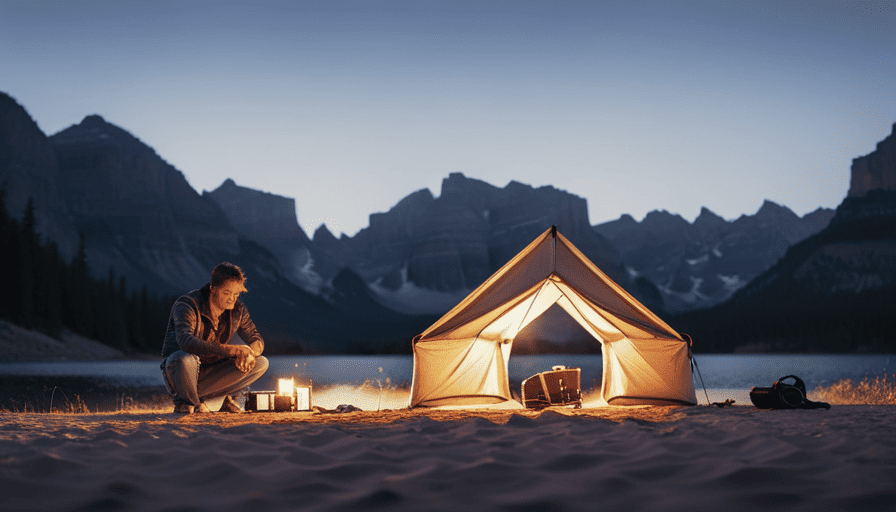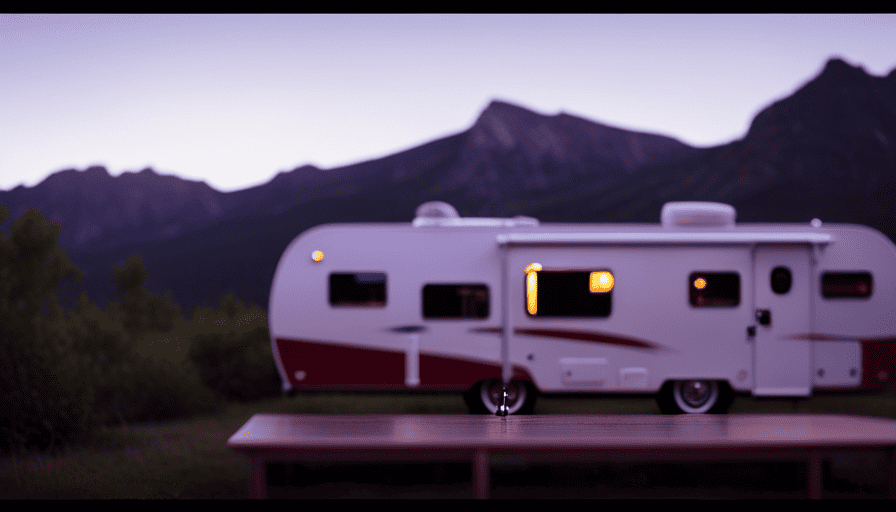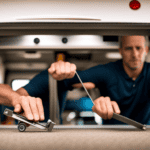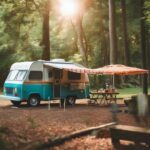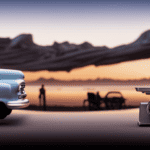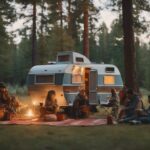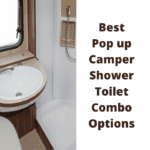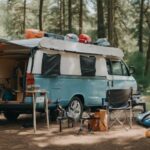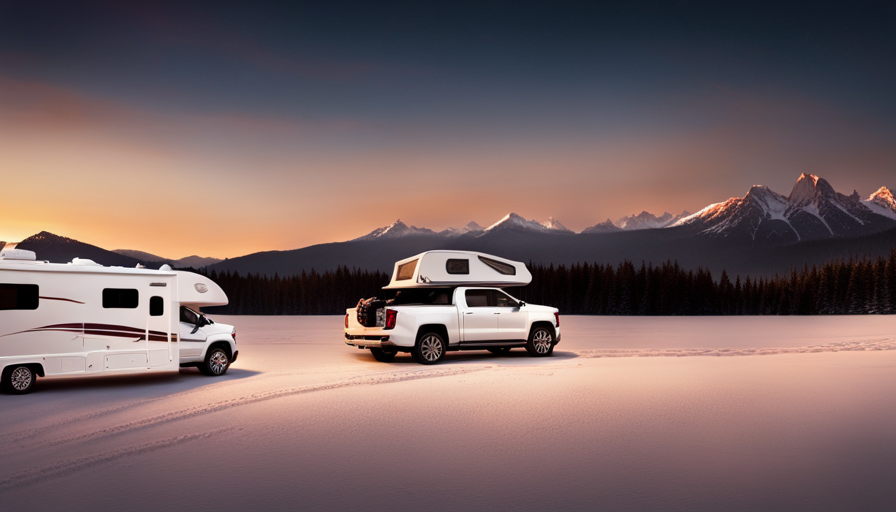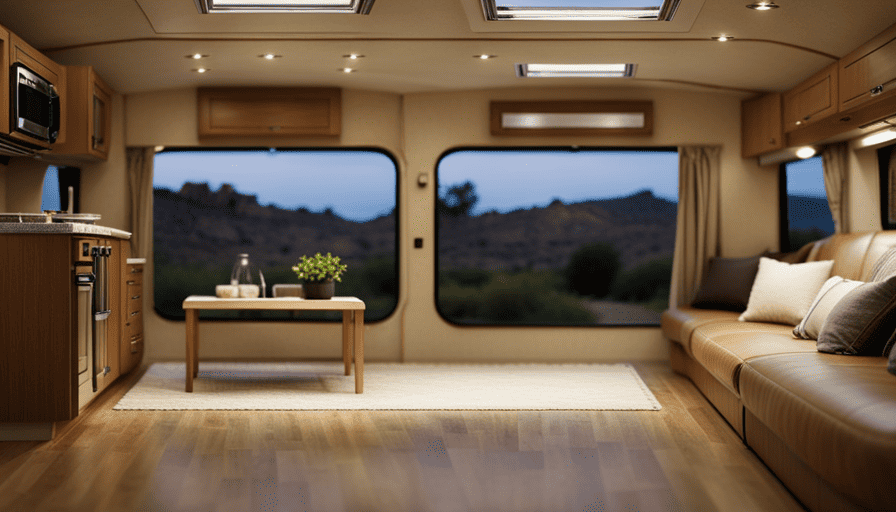So, after enjoying an incredible camping trip in your trusty pop-up camper, it’s time to start packing up and heading home. Folding down your pop-up camper may seem daunting at first, but don’t fret! With a little knowledge and some simple steps to follow, you’ll have your camper safely secured and ready to go in no time.
In this article, I’ll guide you through the process of closing a pop-up camper, ensuring you have a thorough understanding of your camper’s components and manual.
We’ll cover everything from organizing the interior and disconnecting utilities, to collapsing the roof and folding the beds and furniture.
By the end of this article, you’ll have all the necessary skills to confidently close your pop-up camper and prepare for your next adventure.
So, let’s get started and make the packing up process a breeze!
Key Takeaways
- Familiarize yourself with the camper’s manual and components
- Clean and organize the interior of the camper
- Securely collapse the roof and walls according to the manufacturer’s instructions
- Double-check all latches, locks, and connections before driving off
Familiarize Yourself with Your Camper’s Manual and Components
Before attempting to close your pop-up camper, make sure to familiarize yourself with the manual and all of its components. It’s essential to have a good understanding of how your camper works and what each component does.
The manual will provide you with valuable information on how to operate the various systems and how to properly maintain them. Take the time to read through it thoroughly, paying close attention to any specific instructions or warnings.
Once you have familiarized yourself with the camper’s manual, it’s time to take a closer look at the components. Start by identifying the different parts of your camper, such as the roof, sidewalls, and bed frames. Understand how they are connected and how they function. This knowledge will be crucial when it comes to closing your camper properly.
By becoming familiar with your camper’s components and understanding its manual, you will have the necessary knowledge to close your pop-up camper safely and efficiently. With this knowledge, you can confidently move on to the next step: clearing out and organizing the interior of your camper.
This will ensure that everything is tidy and in its proper place before closing it up for storage or travel.
Clear out and Organize the Interior of Your Camper
First, take a moment to tidy up and arrange the inside of your cozy home-on-wheels, making sure everything is neat and organized for your next adventure.
One of the key aspects of closing a pop-up camper is clearing out and organizing the interior. This not only ensures that everything is in its proper place but also makes the closing process much smoother.
To start, consider interior storage solutions. Utilize every nook and cranny to maximize space. Invest in storage bins, hanging organizers, and collapsible furniture to keep your belongings organized and secure during travel. This will make it easier to find items when needed and prevent them from shifting around while on the road.
Cleaning and maintenance tips are also essential. Before closing up, give your camper a thorough cleaning. Vacuum the floors, wipe down surfaces, and clean the kitchen and bathroom areas. Don’t forget to empty and sanitize the fridge and remove any perishable items. Additionally, check for any repairs or maintenance that may be needed, such as fixing loose cabinet handles or replacing worn-out seals.
With the interior tidied up and organized, you’re now ready to move on to the next step: disconnect any utilities and secure loose items. This will ensure a smooth transition as you prepare to close your pop-up camper for storage or travel.
Disconnect any Utilities and Secure Loose Items
Now it’s time to ensure a worry-free journey by disconnecting utilities and securing any loose items inside your cozy mobile retreat. Before closing up your pop-up camper, make sure to disconnect any electrical, water, and propane connections. This will help prevent any potential accidents or damage during transport. Double check that all appliances, such as the stove and refrigerator, are turned off and any water tanks are emptied to avoid leaks.
Next, take a moment to secure any loose items inside the camper. Traveling can cause items to shift and potentially become damaged or even pose a safety hazard. Use bungee cords or straps to secure larger items like chairs, tables, and coolers. Don’t forget to remove any valuable or fragile items and store them in a safe place.
To give you a visual representation of the items you should secure, here is a table that highlights common loose items and their proper storage:
| Item | Storage Solution |
|---|---|
| Chairs | Stack and secure |
| Tables | Fold and bungee cord |
| Coolers | Strap down |
| Kitchen utensils | Store in drawers |
| Electronics | Pack in padded bags |
By disconnecting utilities and packing away loose items, you’ll be well-prepared for a smooth and worry-free journey. Now, let’s move on to the next step and collapse the roof and walls of your camper.
Collapse the Roof and Walls of Your Camper
To make your cozy mobile retreat ready for travel, it’s time to collapse the roof and walls of your camper, creating a compact and streamlined form for the journey. Here are four easy steps to guide you through the process:
-
Secure loose items: Before collapsing the roof and walls, make sure to remove any loose items and stow them away in storage options provided. This will prevent any damage or loss during the folding process.
-
Check for maintenance issues: Take a moment to inspect the roof and walls for any signs of wear and tear. Addressing any maintenance issues now will save you from potential headaches later on.
-
Follow manufacturer’s instructions: Each pop-up camper may have slight variations in the collapsing process, so it’s important to consult the manufacturer’s instructions. This will ensure you’re closing your camper correctly and efficiently.
-
Store the collapsed camper properly: Once the roof and walls are collapsed, secure them using the designated latches or straps. This will prevent any accidental opening while on the road.
With the roof and walls collapsed, it’s time to move on to the next step: folding and securing the beds and furniture, ensuring everything’s ready for your next adventure.
Fold and Secure the Beds and Furniture
Once you’ve successfully collapsed the roof and walls, you’ll be eager to discover the next crucial step: effortlessly folding and securing the beds and furniture in your cozy mobile retreat. This is an important part of the process to ensure the longevity and proper maintenance of your camper.
When it comes to the beds, start by removing all bedding and cushions. Fold them neatly and place them in a designated storage area. For the larger beds, make sure to secure them with straps or bungee cords to prevent any movement during transit.
When it comes to the furniture, it’s essential to take a few extra steps to ensure its longevity. Start by cleaning and wiping down all surfaces to remove any dirt or debris. This will prevent any damage or stains from occurring while in storage. Next, fold and collapse any tables or chairs and secure them with straps or bungee cords. This will prevent them from unfolding or moving during transit.
Now that you have successfully folded and secured the beds and furniture, you can move on to the next step: collapsing the dining area and kitchenette. This will ensure that your pop up camper is fully closed and ready for storage or transportation.
Collapse the Dining Area and Kitchenette
After effortlessly folding and securing the beds and furniture, the next step is to collapse the dining area and kitchenette, ensuring a seamless transition for your mobile retreat.
To collapse the dining area, start by removing any loose items such as dishes or utensils from the table and stow them away. Next, release any latches or locks that are holding the table in place. Gently fold the table down, making sure to keep your fingers clear of any moving parts. Secure the table in its collapsed position using the provided straps or latches.
Moving on to the kitchenette, begin by emptying all cabinets and drawers of any loose items. This will prevent any items from shifting or falling during the collapsing process. Once everything is cleared out, locate the release mechanisms on the kitchenette. These’re usually located on the sides or underneath the countertop. Release the mechanisms and carefully fold the kitchenette down, ensuring that all parts are properly aligned and secured.
With the dining area and kitchenette collapsed and secured, you’re now ready to move on to the next step of locking and securing all latches and fasteners. This’ll ensure that everything stays in place while you travel.
Lock and Secure all Latches and Fasteners
Now it’s time for you to ensure the safety and stability of your mobile retreat by locking and securing all latches and fasteners. This step is crucial in preventing any unexpected movement or damage while you’re on the road.
Here are three key points to consider when it comes to lock maintenance and securing windows:
-
Double-check all latches: Go around your pop-up camper and inspect all the latches on doors, cabinets, and storage compartments. Make sure they’re in good working condition and securely latched. If you notice any loose or damaged latches, replace them before hitting the road.
-
Secure windows: Give all the windows a thorough inspection, making sure they’re securely closed and locked. This not only prevents potential leaks during rainy weather but also deters unwanted intrusions. If you notice any issues with the window locks, consider replacing them or using additional security measures like window bars or locks.
-
Tighten all fasteners: Take a moment to tighten all the screws, bolts, and nuts throughout your camper. Over time, these fasteners can become loose due to vibrations and movement. By tightening them, you’ll ensure that everything stays in place, reducing the risk of accidents or damage.
Now that you’ve taken care of locking and securing your camper, it’s time to move on to the next step: stowing away the awning and outdoor equipment.
Stow Away Awning and Outdoor Equipment
To ensure a safe and secure journey, make sure to stow away the awning and outdoor equipment of your mobile retreat. Stowing camping gear and securing outdoor furniture are essential steps in preparing your pop-up camper for travel.
Before folding down the camper, take the time to carefully remove any camping gear, such as chairs, tables, and grills, that may be attached or stored outside. It’s important to secure these items properly inside the camper to prevent them from shifting and causing damage during transit.
When it comes to the awning, carefully retract it and make sure it’s securely fastened in its designated storage area. This’ll protect it from potential damage caused by wind or debris while on the road. Additionally, be sure to check that all outdoor equipment, such as bikes or kayaks, is properly secured to the camper or stored away safely.
By stowing away the awning and outdoor equipment, you not only protect them from potential damage but also ensure a smooth and worry-free journey. Once everything is safely stored, it’s time to move on to the next step: double-checking all connections and seals to ensure a tight and secure closure of your pop-up camper.
Double Check all Connections and Seals
Make sure to double-check all connections and seals in order to ensure a tight and secure closure of your camper, which is crucial for preventing any potential leaks or damage during your journey. Here are four important steps to take when double-checking your connections and seals:
-
Double-check electrical connections: Before closing up your pop-up camper, it’s important to ensure that all electrical connections are secure. This includes checking that the power cord is properly plugged in and that all lights and appliances are turned off. This’ll help prevent any electrical issues while on the road.
-
Inspect for any damages: Carefully inspect all connections and seals for any signs of wear or damage. Look for any loose or frayed wires, cracked seals, or broken hinges. Repair or replace any damaged parts as needed to maintain the integrity of your camper.
-
Test the watertightness: To ensure a watertight seal, spray water around all windows, doors, and seams. Check for any signs of water leakage or moisture. If you notice any leaks, reseal the affected areas with appropriate sealant to prevent water damage.
-
Secure all latches and locks: Lastly, make sure that all latches and locks are properly secured. This includes securing the door, windows, and any exterior compartments. This’ll help prevent any items from shifting or falling out during your journey.
By double-checking all connections and seals, you can ensure a secure closure of your pop-up camper. This’ll give you peace of mind knowing that your camper is ready for your next adventure.
Next, we’ll discuss the importance of practicing the closing and opening of your camper for easy set-up and pack-up.
Practice Closing and Opening Your Camper for Easy Set-Up and Pack-Up
Get ready for hassle-free adventures by practicing the smooth closing and opening of your camper, ensuring a stress-free set-up and pack-up experience. By practicing these techniques, you can become proficient in closing and opening your pop-up camper, saving time and avoiding common mistakes.
One important technique to practice is properly folding and collapsing the camper. Start by removing any loose items and securing all doors and windows. Begin by folding down the bunk ends, making sure they’re securely latched. Then, collapse the walls by pushing them inward, ensuring they’re aligned and locked into place. It may take a few tries to get the hang of it, but with practice, you’ll be able to do it effortlessly.
Another common mistake to avoid is neglecting to secure all the latches and locks. Double-check that all the latches are securely fastened and locked before driving off. This’ll prevent any unexpected openings or damage during transit.
Lastly, practice setting up and packing up your camper in different weather conditions. This’ll prepare you for any situation you may encounter while on your adventures. By practicing these techniques and avoiding common mistakes, you’ll be well-prepared to enjoy stress-free camping experiences with your pop-up camper.
Frequently Asked Questions
How do I properly secure loose items inside the camper before closing it?
Before closing the pop-up camper, I make sure to secure all loose items inside by organizing the storage space. It’s crucial to keep valuables from shifting during transportation.
I use bungee cords and cargo nets to fasten items in place, creating a safe and organized environment. This prevents any potential damage or accidents while on the road.
By taking these precautions, I can confidently close the camper, knowing everything is properly secured.
What steps should I take to disconnect any utilities before closing the camper?
To disconnect utilities from a pop-up camper, such as electricity and water supply, start by turning off the main power switch and unplugging any cords.
Next, shut off the water source and drain any remaining water from the system.
Make sure to properly secure loose items inside the camper before closing it, ensuring a safe and smooth closure. This will prevent any damage or accidents during transit.
Are there any specific techniques or tips for collapsing the roof and walls of a pop-up camper?
As an experienced camper, I’ve discovered a few useful techniques and tips for collapsing the roof and walls of a pop-up camper.
When it comes to techniques, one handy trick is to start with the corners and work your way towards the center. This helps ensure a smooth collapse without any snags or tangles.
As for tips, make sure to double-check all latches and locks before collapsing to avoid any unexpected surprises.
How can I effectively fold and secure the beds and furniture inside the camper?
To effectively fold and secure the beds and furniture inside the camper, I use a combination of folding techniques and securing methods.
Firstly, I collapse the beds by folding them in half and securing them with straps or bungee cords to prevent any movement during travel.
For the furniture, I make sure to remove any loose items and secure them in cabinets or drawers. Additionally, I utilize Velcro straps or bungee cords to secure larger pieces of furniture in place to prevent them from shifting while on the road.
Are there any special precautions or considerations when stowing away the awning and outdoor equipment?
When it comes to storing outdoor equipment and the awning while closing a pop-up camper, there are a few important tips to keep in mind. Firstly, make sure to clean and dry any outdoor equipment before stowing it away to prevent mold or damage.
Secure loose items inside the camper by using bungee cords or storage nets.
As for the awning, be sure to retract it properly, following the manufacturer’s instructions, to avoid any damage during transportation.
Is Closing a Pop Up Camper the Same as Backing Up a Pop Up Camper?
Closing a pop up camper involves folding it down and securing it for travel, while backing up a pop up camper refers to the act of maneuvering it in reverse. Although these two actions are both essential for using a pop up camper, they serve different purposes and require different skills.
Conclusion
In conclusion, closing a pop up camper may seem daunting at first, but with the right knowledge and organization, it can be a smooth and efficient process. By following the steps outlined in this article and familiarizing yourself with your camper’s manual, you can easily collapse the roof and walls, fold and secure the beds and furniture, and stow away any outdoor equipment.
Remember to double-check all connections and seals for a tight and secure closure. So why wait? Get out there and enjoy your next camping adventure!

